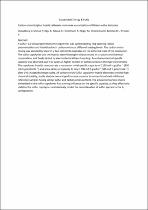 ResearchSpace
ResearchSpace
Carbon onion/sulfur hybrid cathodes via inverse vulcanization for lithium-sulfur batteries
JavaScript is disabled for your browser. Some features of this site may not work without it.
- ResearchSpace
- →
- Research Publications/Outputs
- →
- Journal Articles
- →
- View Item
| dc.contributor.author |
Choudhury, S

|
|
| dc.contributor.author |
Srimuk, P

|
|
| dc.contributor.author |
Raju, Kumar

|
|
| dc.contributor.author |
Tolosa, A

|
|
| dc.contributor.author |
Fleischmann, S

|
|
| dc.contributor.author |
Zeiger, M

|
|
| dc.contributor.author |
Ozoemena, KI

|
|
| dc.contributor.author |
Borchardt, L

|
|
| dc.contributor.author |
Presser, V

|
|
| dc.date.accessioned | 2019-04-10T10:34:18Z | |
| dc.date.available | 2019-04-10T10:34:18Z | |
| dc.date.issued | 2018-01 | |
| dc.identifier.citation | Choudhury, S. et.al. 2018. Carbon onion/sulfur hybrid cathodes via inverse vulcanization for lithium-sulfur batteries. Sustainable Energy & Fuels, v2(1), pp 133-146 | en_US |
| dc.identifier.issn | 2398-4902 | |
| dc.identifier.uri | https://pubs.rsc.org/en/content/articlehtml/2018/se/c7se00452d?page=search | |
| dc.identifier.uri | http://hdl.handle.net/10204/10927 | |
| dc.description | Copyright: 2018 Royal Society of Chemistry. Due to copyright restrictions, the attached PDF file only contains the abstract of the full text item. For access to the full text item, kindly consult the publisher's website. | en_US |
| dc.description.abstract | A sulfur–1,3-diisopropenylbenzene copolymer was synthesized by ring-opening radical polymerization and hybridized with carbon onions at different loading levels. The carbon onion mixing was assisted by shear in a two-roll mill to capitalize on the softened state of the copolymer. The sulfur copolymer and the hybrids were thoroughly characterized in structure and chemical composition, and finally tested by electrochemical benchmarking. An enhancement of specific capacity was observed over 140 cycles at higher content of carbon onions in the hybrid electrodes. The copolymer hybrids demonstrate a maximum initial specific capacity of 1150 mA h gsulfur -1 (850 mA h gelectrode -1) and a low decay of capacity to reach 790 mA h gsulfur-1 (585 mA h gelectrode -1) after 140 charge/discharge cycles. All carbon onion/sulfur copolymer hybrid electrodes yielded high chemical stability, stable electrochemical performance superior to conventional melt-infiltrated reference samples having similar sulfur and carbon onion content. The amount of carbon onions embedded in the sulfur copolymer has a strong influence on the specific capacity, as they effectively stabilize the sulfur copolymer and sterically hinder the recombination of sulfur species to the S8 configuration. | en_US |
| dc.language.iso | en | en_US |
| dc.publisher | Royal Society of Chemistry | en_US |
| dc.relation.ispartofseries | Worklist;20173 | |
| dc.title | Carbon onion/sulfur hybrid cathodes via inverse vulcanization for lithium-sulfur batteries | en_US |
| dc.type | Article | en_US |
| dc.identifier.apacitation | Choudhury, S., Srimuk, P., Raju, K., Tolosa, A., Fleischmann, S., Zeiger, M., ... Presser, V. (2018). Carbon onion/sulfur hybrid cathodes via inverse vulcanization for lithium-sulfur batteries. http://hdl.handle.net/10204/10927 | en_ZA |
| dc.identifier.chicagocitation | Choudhury, S, P Srimuk, Kumar Raju, A Tolosa, S Fleischmann, M Zeiger, KI Ozoemena, L Borchardt, and V Presser "Carbon onion/sulfur hybrid cathodes via inverse vulcanization for lithium-sulfur batteries." (2018) http://hdl.handle.net/10204/10927 | en_ZA |
| dc.identifier.vancouvercitation | Choudhury S, Srimuk P, Raju K, Tolosa A, Fleischmann S, Zeiger M, et al. Carbon onion/sulfur hybrid cathodes via inverse vulcanization for lithium-sulfur batteries. 2018; http://hdl.handle.net/10204/10927. | en_ZA |
| dc.identifier.ris | TY - Article AU - Choudhury, S AU - Srimuk, P AU - Raju, Kumar AU - Tolosa, A AU - Fleischmann, S AU - Zeiger, M AU - Ozoemena, KI AU - Borchardt, L AU - Presser, V AB - A sulfur–1,3-diisopropenylbenzene copolymer was synthesized by ring-opening radical polymerization and hybridized with carbon onions at different loading levels. The carbon onion mixing was assisted by shear in a two-roll mill to capitalize on the softened state of the copolymer. The sulfur copolymer and the hybrids were thoroughly characterized in structure and chemical composition, and finally tested by electrochemical benchmarking. An enhancement of specific capacity was observed over 140 cycles at higher content of carbon onions in the hybrid electrodes. The copolymer hybrids demonstrate a maximum initial specific capacity of 1150 mA h gsulfur -1 (850 mA h gelectrode -1) and a low decay of capacity to reach 790 mA h gsulfur-1 (585 mA h gelectrode -1) after 140 charge/discharge cycles. All carbon onion/sulfur copolymer hybrid electrodes yielded high chemical stability, stable electrochemical performance superior to conventional melt-infiltrated reference samples having similar sulfur and carbon onion content. The amount of carbon onions embedded in the sulfur copolymer has a strong influence on the specific capacity, as they effectively stabilize the sulfur copolymer and sterically hinder the recombination of sulfur species to the S8 configuration. DA - 2018-01 DB - ResearchSpace DP - CSIR LK - https://researchspace.csir.co.za PY - 2018 SM - 2398-4902 T1 - Carbon onion/sulfur hybrid cathodes via inverse vulcanization for lithium-sulfur batteries TI - Carbon onion/sulfur hybrid cathodes via inverse vulcanization for lithium-sulfur batteries UR - http://hdl.handle.net/10204/10927 ER - | en_ZA |





